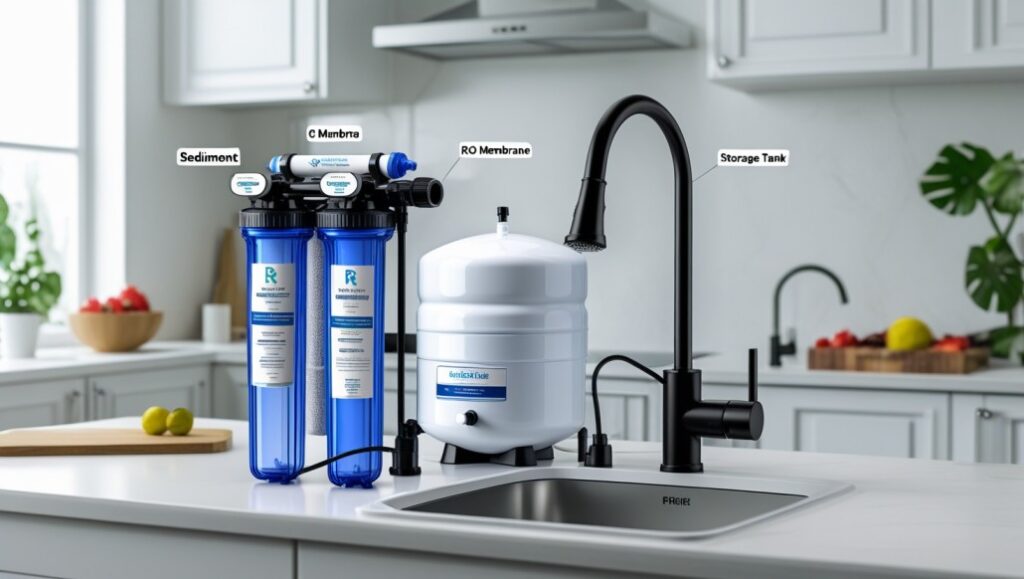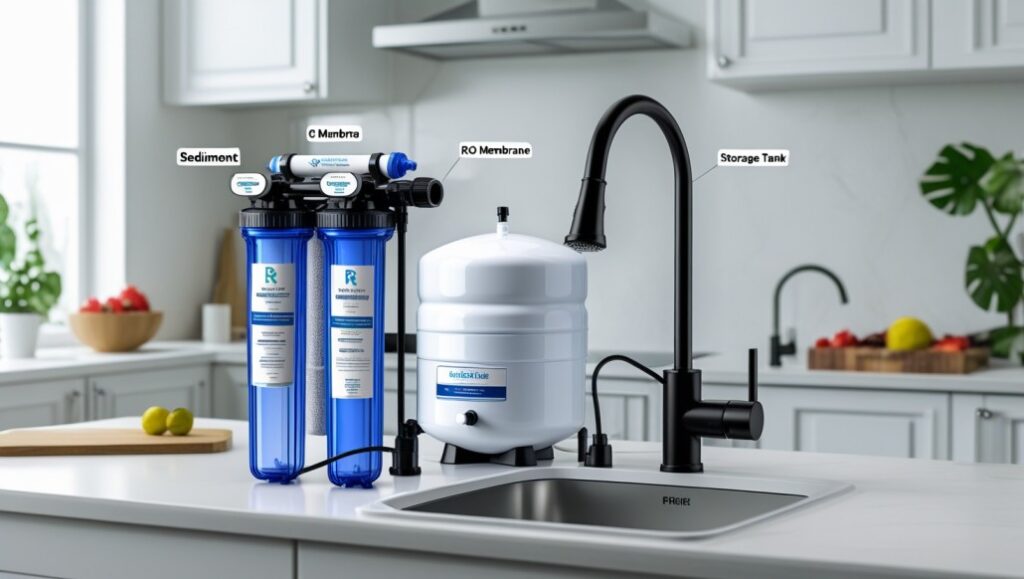Introduction
It’s surprising how little we think about the water we drink—just turn on the tap, and voilà! Yet, the journey from source to sipping glass can hide impurities you’d rather not consume. That’s where a reverse osmosis (RO) filter steps in. In a world becoming more health-conscious, understanding how RO systems work, why they matter, and how to pick one can make all the difference. In this blog, we’ll unpack everything you need: from basics to the best models, sprinkled with practical maintenance advice and SEO-friendly insights. Ready to dive in?
What Is an RO Filter and Why Do You Need One
A reverse osmosis filter uses a semi-permeable membrane to remove contaminants like lead, chlorine, nitrates, fluoride, and microbes. Think of it as a finely-tuned sieve that ensures only pure water molecules pass through. Unlike basic carbon filters that tackle taste and odor, RO systems take purification to the next level—often removing up to 99% of harmful substances.

Health & Wellness Benefits
- Cleaner, safer water reduces risks of consuming heavy metals or pathogens.
- Better-tasting water enhances cooking, coffee, and even hydration habits.
- Convenient and cost-effective compared to buying bottled water over time.
How an RO System Works: The 5-Step Journey
- Sediment Filter – Removes sand, silt, and rust.
- Carbon Filter – Eliminates chlorine, pesticides, and unpleasant taste.
- RO Membrane – The star of the show, filtering out dissolved solids.
- Post-Carbon Filter – Final polishing for taste and odor.
- Storage Tank – Stores the purified water, ready for dispensing.
The process might sound elaborate, but it’s elegantly efficient.

Types of RO Systems
| System Type | Best For |
| Under-Sink RO | Most popular for households |
| Countertop RO | Portable and no installation needed |
| Whole-House RO | Offers purified water throughout the home |
| Commercial RO | Ideal for restaurants or businesses |
Choosing the Right RO System
- Capacity Matters – A typical under-sink unit provides 50–75 gallons of water daily.
- Stages of Filtration – More stages = more purification, but also more maintenance.
- Certifications to Look For – NSF, WQA, and ANSI seals ensure performance and safety.
- Installation Ease – Decide if you’re up for a DIY project or want a pro.
- Wastewater Ratio – Efficient units can waste as little as 1 gallon per 3–4 gallons purified.
Maintenance Tips: Keep That Filter Fresh
- Replace pre-filters every 6–12 months to protect the RO membrane.
- RO membrane swap every 2–3 years, depending on water quality.
- Sanitize the storage tank annually to avoid algae or bacterial buildup.
- Monitor pressure gauge: A drop indicates it’s time for a change.
- Check for leaks monthly—a little vigilance goes a long way.
Top 3 RO Systems Worth Considering
- Apex Countertop RO-CT-19 – Sleek, portable, and under-$300. Perfect for renters or travelers.
- Home Master TMHP HydroPerfection – A whole-house hero with UV sterilization, ideal if you’re serious about purity for every tap.
- iSpring RCC7 Under-Sink – Trusted, certified, and budget-friendly (~$200). A great starter RO system.
Each offers distinct perks, catering to different needs—whether it’s mobility, full-home coverage, or affordability.
Benefits of RO Filters in Daily Life
- Eco-Friendly: Less plastic waste, fewer bottled water purchases.
- Cost Savings: Break-even often within one year compared to bottled water.
- Appliance Longevity: Cleaner water means less scale buildup in kettles and coffee makers.
- Health-Conscious Choice: Ideal for households with kids, seniors, or anyone on immune compromise.
Addressing Common Misconceptions
- “RO water is demineralized and unhealthy.”
True—RO removes beneficial minerals—but most quality systems have remineralization stages or you can ensure mineral intake through diet. - “Too much water gets wasted.”
Older systems waste more, yes. But newer, efficient models reduce that significantly—look for units with a 3:1 or better ratio.
Integrating with SEO & Internal Linking Strategy
To improve site visibility:
- Link keywords like “replace RO membrane” to your internal guide covering filter-change steps.
- Mention “whole house RO system benefits” and point users to a comparison post you might have.
- Use “eco-friendly water purifier” as anchor text to direct traffic to sustainability-focused content.
This strategy not only boosts SEO but helps create a cohesive user journey through your site.
Humanized Wrap-Up
Let’s be real: water is the lifeblood of our days—coffee in the morning, soups for dinner, that mid-afternoon glass of refreshment. Why compromise purity when a manageable investment like an RO filter can elevate your daily routine? I’ll never forget the first time I tasted real RO water—so crisp, so clean—it made brewing a perfect cup feel downright luxurious.
Final Thoughts
RO systems might seem technical at first glance, but once you’ve got the lay of the land—from stages and membranes to maintenance and efficiency—they’re surprisingly user-friendly. Whether you’re a renter, homeowner, or eco-warrior, there’s an RO setup that aligns with your lifestyle and values. The result? Cleaner taste, better health, and peace of mind—gleaming like clear water itself.
Related Posts to Explore
- How to Replace an RO Membrane in 5 Easy Steps
- Whole House RO vs Under-Sink: Which One’s Right for You?
- Eco-Friendly Water Purifiers: Beyond RO
Related FAQs About RO Filters
1. What is the lifespan of an RO filter?
Most RO systems last anywhere from 10 to 15 years if maintained properly. Individual filter cartridges typically need replacement every 6 to 12 months, while the RO membrane may last 2 to 3 years.
2. Does RO water remove essential minerals?
Yes, RO systems remove most minerals along with harmful contaminants. However, some advanced models include a remineralization stage to add back healthy minerals like calcium and magnesium.
3. Is RO water safe to drink daily?
Absolutely. While it’s low in minerals, RO water is free from heavy metals, bacteria, and chemicals. Just ensure a balanced diet to compensate for any mineral loss.
4. How much water does an RO system waste?
Older RO systems could waste 3–4 gallons per every 1 gallon of filtered water. Newer, efficient models are much better, with some offering 1:1 or 2:1 wastewater ratios.
5. Can I install an RO filter myself?
Yes, many under-sink RO units are DIY-friendly and come with installation kits. However, if you’re unsure or dealing with a whole-house system, professional installation is safer.
6. How do I know when to replace the RO membrane?
Signs include a noticeable drop in water flow, a strange taste or odor, or a rise in total dissolved solids (TDS) levels—check with a TDS meter if you have one.
7. Are there any drawbacks to using an RO system?
Besides initial cost and regular maintenance, the only real drawback is water wastage, which can be mitigated with high-efficiency models and reuse strategies (like watering plants).
8. Can RO filters remove viruses?
RO systems can filter out most viruses due to the membrane’s fine pores, but they’re often paired with UV or UF stages for extra microbial protection.
.jpg)

No comments:
Post a Comment